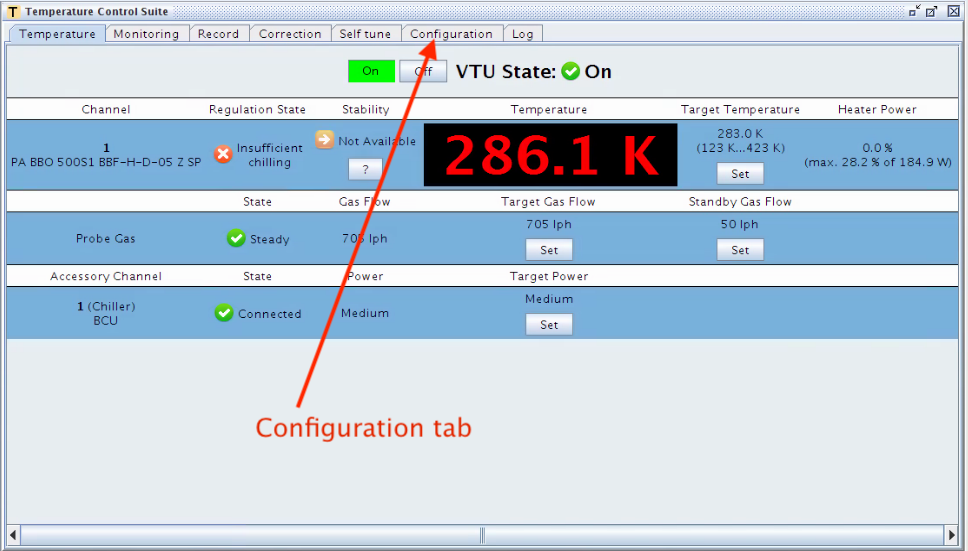

The KovriginNMR VT software suite helps the NMR user safely control Bruker variable-temperature unit parameters to reach accurately calibrated temperatures in the full temperature range of the probe. A casual NMR user will appreciate a single-click functionality while an expert NMR users will enjoy automation of time-consuming tasks such as finely resolved temperature series or kinetic series at different sample temperatures.
The distinctive features of KovriginNMR VT are:
IMPORTANT: The KovriginVT sofware is intended for the NMR users who took the Variable-Temperature Control training with Dr. Kovrigin.
Before starting your variable temperature work, you need to check several settings of the Variable Temperature Unit of your instrument:



To change the Variable Temperature Unit (VTU) to the temperature required for you NMR experiment, do the following:


Once you click OK, the KovriginVT begins a stepwise temperature ramp to your target range. Software takes 5-degree steps and waits for the sample temperature to catch up before incrementing next. This gentle ramping mode preserves integrity of the expensive glass components of the probe.
A small window indicating that VTU is in operation pops up (this is automatic response for the VTU, not part of KovriginVT)

You may click OK or just ignore it. It will be automatically dismissed by the next message window.
IMPORTANT: While KovriginVT is ramping to the temperature, you must keep the same EXPNO displayed that you started Ramp to T from. This is necessary because KovriginVT saves operating parameters in the current dataset. If you switch the experiment or issue edte, the KovriginVT will abort the ramp. In this case, you should switch back to the same EXPNO and restart the Ramp to T.
To satisfy the need for information in the EDTE window that helps visually monitor VTU paramters, KovriginVT includes a Show Status toolbar button. The resulting window displays all parameters of the Variable Temperature Unit.

Important to note that the Show Status window lists both the direct (uncorrected) readings/settings of the VTU and recalculated corrected K or C values of the sample temperature, for user convenience. The direct readings called K VTU and C VTU are the same as the number shown on the Probe Temperature window of the Topspin status bar:

Note for an expert NMR user: If you need to use Topspin (open edte or browse other datasets) while KovriginVT is in operation, issue newtop on the Topspin command line and do all what you need in that second Topspin window. The first Topsin window must remain in the same experiment.
You may follow the progress of the temperature ramp by clicking Show Report button on the KovriginVT toolbar. The button displays an HTML document Temperature_ramp_log.html that is a log of the KovriginVT operation. This document is saved in your dataset EXPNO and is continually updated so you may refresh the browser window to view the newest messages.
Sometimes, when you moved very far from the range where VTU was last self-tuned, the warning from VTU may pop up:

If your response to Stabilized and tuned? was 'no', it is safe to click Close and ignore this message because the KovriginVT will self-tune at the end of the ramp. If you said 'yes', you will have to repeat Ramp to T with Stabilized and tuned? set to 'no' and the same target temperature. The system will not change temperature but trigger the self-tuning routine of the VTU.
When temperature ramp is finished and the spectrometer is ready for the NMR experiment, KovriginVT displays a message:

as well as updates the HTML log with the final message: "Temperature ramp is complete. VTU is stable."
At this point, you may proceed with your NMR experiment. Click Back to Acquire to exit KovriginVT.
At any point in the temperature ramp, you may stop KovriginVT by clicking Abort Ramp. You will see a message:

The software quits in a short while. One exception is when self-tune routine has started as indicated by a message "Starting self-tuning routine." in the HTML log. This may also be observed by looking at the probe temperature display in the Topspin status bar: the Self tune and Reg. State symbols are both dark-violet rectangles:

In this case, you must wait till self-tune of the VTU finishes. KovriginVT quits automatically after self-tune is complete with this message:

If KovriginVT was aborted, the VTU stays at the currently acquired temperature. To move from this temperature, use Ramp to T again.
The progress of this end-of-work ramp is logged in the html document 'Return_to_RT_log.html' saved in the current EXPNO. The document is continually updated, so you may refresh the internet browser window to see the progress of the return ramp. For example:

Double clicking on 'Return_to_RT_log.html' launches internet browser with display of the ramp log

Once the system arrived at 298K, it resets the parameters of gas flow to match the commonly used POM spinner and self-tunes the VTU. This final step is also logged in 'Final_stabilization_at_RT_log.html'

Upon completion is changes the sample for the position of the standard sample (usually, 1) and locks (usually, CDCl3), tunes, and shims. Report of shimming results is displayed in a separate window.
Finally, the End Work procedure turns off the VTU and exits with the message:

At this stage you may leave the spectrometer to the next user.
IMPORTANT: The user must monitor progress of the automated procedure and intervene if anything goes wrong. In other words, the goal of KovriginVT automation is to relieve the user from a need to type too many commands but not from making final determination whether the system operates as expected.
Back to TopThe KovriginNMR library contains scripts like knmr_script_[description].py. Scripts contain instructions in their headers to explain main functions of the script and direct the user to set up the automated operation.
Back to Top
Evgenii Kovrigin (C) 2022